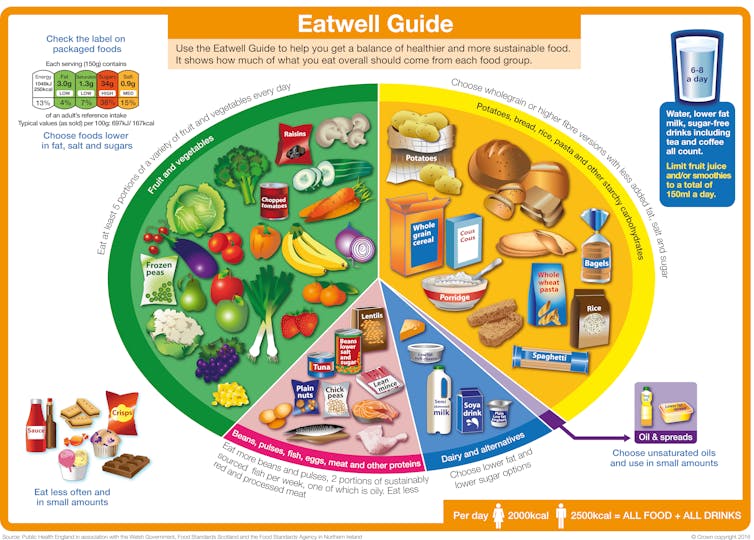The Eatwell plate was a visual guide, in pie-chart form, of the government’s recommended intakes of specified food groups. The chart remained largely unchanged for 20 years. But in October 2014, Public Health England announced that it would update the plate in the light of new recommendations on sugar and fibre from the government’s Scientific Advisory Committee on Nutrition.
Following the announcement, Kremlin Wickramasinghe and I wrote an article for The Conversation arguing that the Eatwell plate actually needed a complete overhaul. We argued that the food groups shown in the plate should be revised, that healthier and less healthy foods within food groups should be identified and very unhealthy foods should not be shown at all. In addition, the angles of the segments of the plate – showing how much of each of the food groups we should eat – should be changed and the environmental sustainability of foods as well as their healthiness should be taken into account.
In March 2016, PHE finally launched an updated Eatwell plate – now called the Eatwell Guide.

So did Public Health England (PHE) take up our recommendations? In some ways, yes. PHE has slightly revised the food groups and they have stopped showing very unhealthy foods (the old Eatwell plate infamously displayed a can of cola). They have commissioned some calculations on the environmental sustainability of the Eatwell Guide diet and it’s certainly an improvement. But most importantly they have changed the angles of the segments of the pie chart to take into account all of the government’s nutrient recommendations – not only the new recommendations on sugar and fibre, but also all the old recommendations for, in particular, fat, saturated fat and salt.
In 2014 we also suggested that the segment for meat, fish and alternatives needed to be smaller than it had been because of the growing evidence for the detrimental effects of meat consumption on health, particularly red and processed meat. But in this we were wrong. It was 12% of the pie in the old Eatwell plate and is still 12% of the pie in the new Eatwell Guide. Twelve percent turns out to be correct because, while we do indeed need to cut down on meat more than we thought 20 years ago, we also need to compensate for that reduction and get our protein from vegetarian alternatives such as beans and pulses. A fifth of our current diet comes from meat, fish and alternatives, so the new Eatwell Guide indicates we still need to reduce that consumption by nearly a half.
All the other angles of the pie chart have changed. The fruit and vegetable segment has increased from 33% to 39%. The bread, other cereals and potatoes segment has increased from 33% to 37%. The fatty and sugary foods segment has been reduced from 8% to 4%. And, controversially, the segment representing milk and dairy foods has nearly halved – from 15% to 8%.
A more scientific approach
These angles have been calculated in a much more transparent and scientific way than they were for the old Eatwell plate where they were essentially a guess. The process involved a technique called optimisation modelling: a computerised way of finding a combination of foods that meets all the nutrient recommendations while at the same time being closest to current dietary habits.
Optimisation modelling means that the recommendations for the different food groups can be broken down into their component parts. For example, although the Eatwell Guide recommends a reduction in meat, fish and alternatives by nearly a half, we show in a new paper in BMJ Open that for this to happen we actually need to reduce our red and processed meat consumption by 80%, to no more than 15g day, and we should increase our consumption of the beans and pulses by 86% to 26g a day.
The Eatwell Guide has changed the name of the meat, fish and alternatives group to “beans, pulses, fish, eggs, meat and other proteins”, but otherwise doesn’t make it clear that eating less meat and more beans and pulses is what is required for a healthy diet which meets the government’s nutrient recommendations.
Our paper also shows that while we need to reduce our overall intake of milk and dairy foods by nearly a half from current levels of 14% to 8% this should be accomplished by reducing our cheese consumption by 85% to no more than 3g a day. But semi-skimmed and skimmed milk consumption should rise slightly from 120 to 127ml a day.
Optimisation modelling resolves some other thorny questions. Can sugary drinks be a component of a healthy diet? The answer is yes, but at only 60g a day this means we should be reducing our consumption to a can a week. Do we need to cut down on fruit juice? Again, yes – by about 50%.
The Eatwell Guide provides all of us with a clear indication of what foods we should be eating. It boils down to eat less meat and processed foods and more plant-based foods, but these new analyses also flesh out what this means precisely. And, for the first time, the recommendations are based on sound science.

